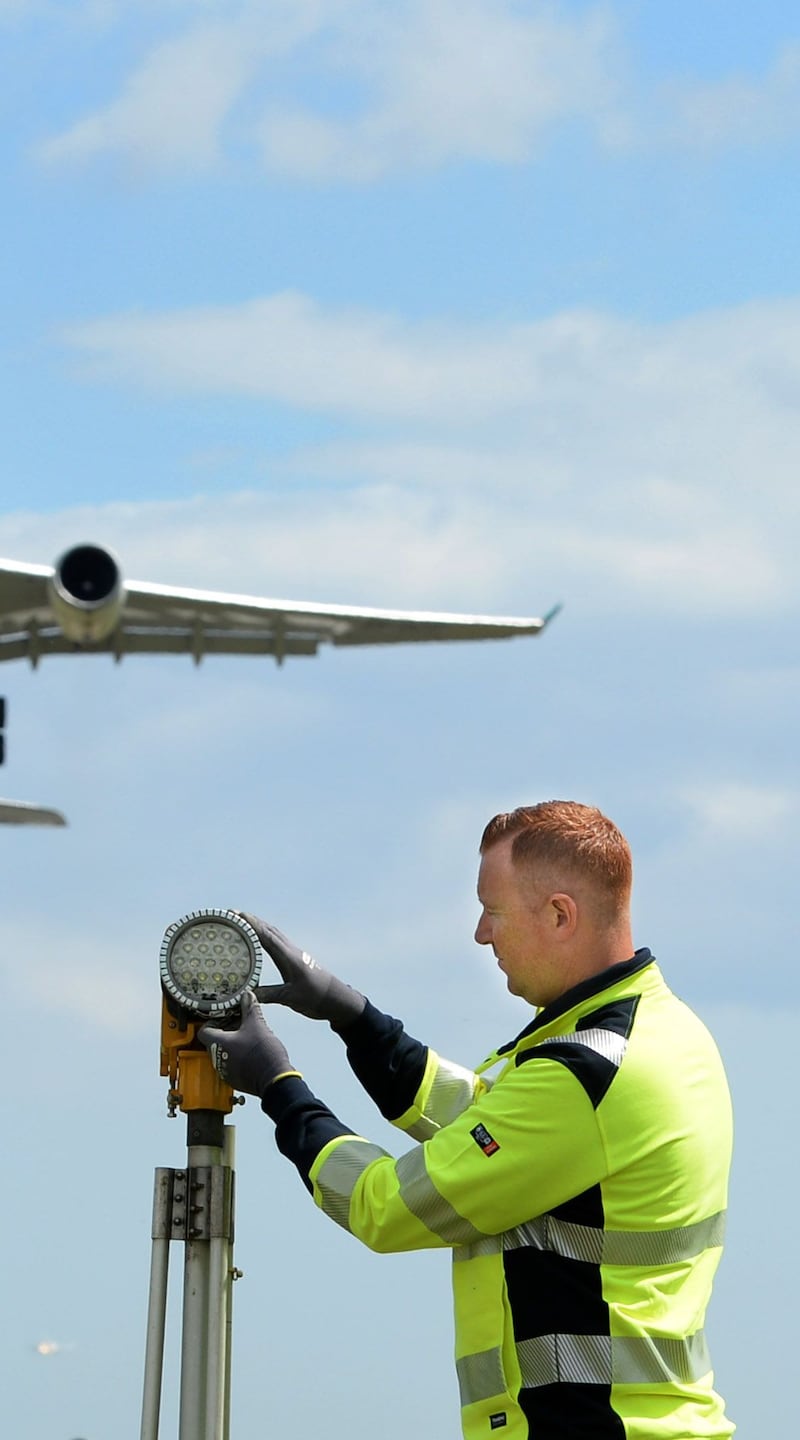Dublin Airport, as the people who work there like to point out, is a city within a city. Nineteen thousand people are employed there, and on its busiest days, 120,000 people, or slightly less than the population of Cork city, pass through. Yet only one person – Fr Des Doyle, airport chaplain since 1964 – actually lives there.
During July, which was the busiest month in the airport’s 79-year history, 3½ million passengers came and went.
You may not know that Dublin Airport has the largest private electricity network in the country, the biggest lost and found department and the biggest bus station
You're probably familiar with some of what makes up this airport-slash-city has: the upmarket perfume and gift shops, the car parks, the Burger Kings, the plush lounges, the duty free, the Starbucks, the Disneyfied Irish pubs, and the long lines of people waiting to check in or drop bags, passport control and security.
You may not know that Dublin Airport also has the largest private electricity network in the country; the biggest lost and found department and the biggest bus station. You might not know that it has daily Mass; its own nursery; four beehives whose 250,000 occupants give the airport its own brand of honey (called Nect-Air, obviously) and a freezer full of dead hares. But we’ll get back to the hares.
I’m spending a day in the airport, seeing behind the scenes of this thriving, citizen-less city.
My day starts at 9am, standing among the polytunnels in the nursery area of the gardening section. In common, I suspect, with most of the people who pass through, I didn’t know that Dublin Airport had its own nursery.
It’s a question of economics, says Owen Tobin, gardening supervisor. “We pot up around 40,000 plants a year. So we buy them in cheap and pot them up ourselves. At retail, you’re looking at €6 a plant. We paid 30 cents each for those plants there.”
Six people work in the gardening area, creating the elaborate floral displays that you see on the roundabouts as you drive in, felling trees, planting hedges, cutting the grass, making wreaths, planting elaborate hanging baskets and looking after landscaping. “We worked out recently that we were looking after 15 acres a head.”
And from November to April, the gardening teams are on call to help with runway de-icing. “We could get a call at 3am. The flights start coming in at about 4.30am. We’ve a big sprayer down there. It’s 45m wide and it covers the whole runway. You go down to the end of the runway, open it up, and then it takes about 11 minutes to do the whole length of the runway.”
So you’d have them both done within the hour and back to bed? “Well, no,” he laughs.
“Then we have to do the different taxiways, around the piers, all of the landside here, the roads and footpaths.”
The hares have actually eaten a little hole in the fence. If they got in at the weekend, you could come in the Monday morning, and everything will be gnawed to the bush
Aside from extreme weather events, what’s the most challenging part of the job? I’m expecting to hear it’s the wind, or the scale of the site. “The hares,” he says immediately.
He points to the perimeter fence. “The hares have actually eaten a little hole in the fence. If they got in at the weekend, you could come in the Monday morning, and everything will be gnawed to the bush.”
We’ll definitely come back to the hares.
Dublin Airport runs a Walk in My Shoes programme, which allows senior managers to work for a day in different divisions. During the summer, the gardening department is very much in demand.
“If you’re out there planting flower beds at this time of year, people stop and talk to and tell you it’s lovely, how lucky you are. But during the winter time they just put their heads down and walk past,” Tobin laughs. “We’ve one of the lads here today.”
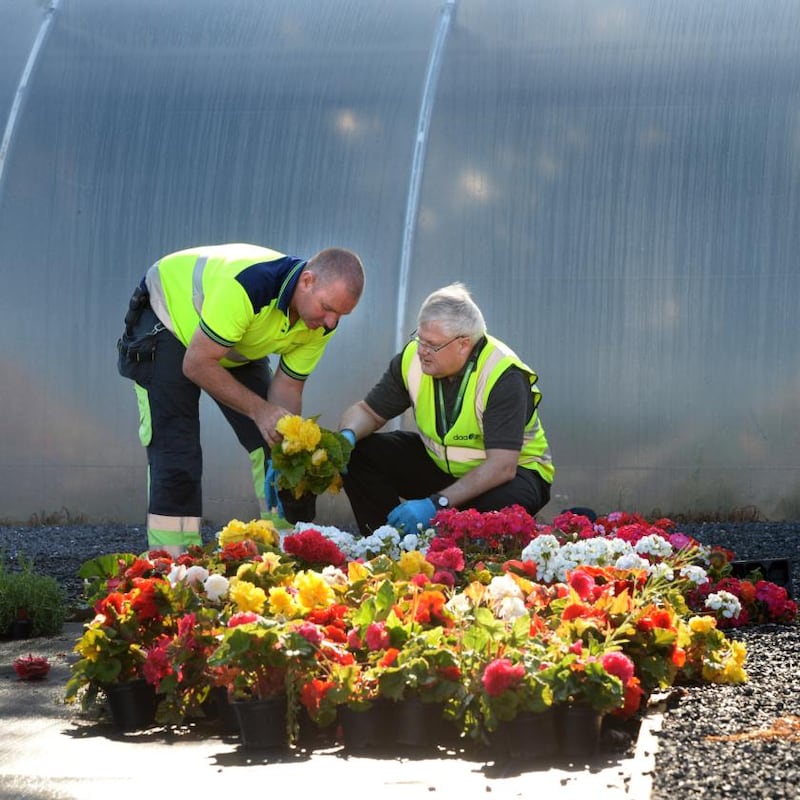
The "one of the lads" is Ray Gray, chief financial officer, who emerges from one of the polytunnels wearing a baseball cap and pushing a wheelbarrow. He's been with the Dublin Airport Authority about 20 years, and has learned a lot he didn't know about the business during his nine Walk in My Shoes placements over the past 12 months.
He’s done “trolleys, car parks, I’ve been in our security area, I’ve been in the retail area in Terminal 1, the maintenance area in T2, the police and fire department.”
Through the programme, you “get to look at the operation in different ways, understand the challenges they deal with, understand what is actually going on behind the scenes”.
He’ll do a full day here, he says. Is the phone off, the out-of-office on? “The phone is off. I don’t put the out-of-office on any more, because there’s no such thing.”
The airport has just experienced its busiest month ever, following nine consecutive years of growth after a slump during 2009-2010, when it lost five million passengers in two years.
DAA is, he says, “in a very good position right now, in that that we have the north runway under construction. We have agreement on a €2 billion capital investment plan.
“But the fly – it’s not a fly, it’s a rock – in the ointment here is that our price regulation, which is done independently, has said that the prices should drop by 22 per cent whilst the airport capacity should double, and that doesn’t make sense.”
The impact of a no-deal Brexit would be 'multifarious, because on the one hand you have the impact on sterling, the business uncertainty', the practical 'questions of how does the airport work around things like customs and cargo'
In May, it was reported that the Commission for Aviation Regulation wanted Dublin Airport to cut the passenger charges it levies on airlines from the current levels of €9.65 a head to €7.50 a head from next year. DAA immediately hit back, saying this would jeopardise its planned capital investments.
Gray is not convinced lower prices would ever be passed on to passengers. “Our proposition is flat prices from 2010 to 2025 – actually lower in real terms – while doubling the asset base. We think that’s a very compelling proposition. The alternative is chaos.”
Since he mentioned chaos, is the prospect of a hard Brexit keeping him awake at night? Not exactly, he says, though he’s been convinced since March that we’re heading for one. The impact of a no-deal departure would be “multifarious, because on the one hand you have the impact on sterling, the business uncertainty”, the practical “questions of how does the airport work around things like customs and cargo”.
On the other side are “the broader, macro impacts, like Britain now essentially moving away from connectivity with Europe on areas like Iran, and tying in with Trump”.
The crew are standing around waiting for him, so he picks up his wheelbarrow and gets back to work. Does he really have to pitch in like any other member of the team or does he get the VIP treatment on his placements?
“No soft treatment,” he says.
In baggage reclaim I meet Aidan Mullally standing beside a pair of pet carriers holding two well-behaved Labradors. “Are you doing an article? If you had been here two minutes ago, you’d have seen someone reunited with their cat off the plane.
“This Russian girl had her cat checked in, and she came running down looking for it,” he says. When she found her cat, “she just broke down. I mean, I love cats, but you’d want to see her. Distraught, she was.”
Mullally used to work for DAA, but now he’s employed by Luggage Delivery Service. “I can’t get away from this place. You become institutionalised.”
On our way to our next stop, DAA’s head of external communications, Siobhán O’Donnell, tells me about the bees. Dublin Airport has four beehives, which are home to 250,000 Irish dark native honeybees. They produce the Nect-Air honey, which you can now buy in the airport.
Beekeeper Colm Fogarty has been out on emergency calls a few times over the summer, when swarms of bees surrounded vehicles on the tarmac. She shows me a video a maintenance technician sent her, shot from the inside of his vehicle, which was completely covered in bees.
Gerry Keogh is chief fire officer and head of a team that has saved 28 lives and delivered one baby, a little girl born in the toilets of Terminal 1 a decade ago
“You’ll have to excuse the language,” she says, as the technician reacts in the same manner I suspect most of us would to the thousands of bees descending on his vehicle. There is a lot of swearing. It’s like a scene from Hitchcock.
The insects are too small to present a risk to planes, she says. The same cannot be said of birds.
Over at the fire station, Gerry Keogh is chief fire officer and head of a team that has saved 28 lives and delivered one baby, a little girl born in the toilets of Terminal 1 a decade ago. “If you look at Croke Park at the weekend, it has over a hundred thousand people. We have that coming in here every day this year. And everybody has a story to tell.”
Full emergencies are not common, but there are frequent callouts for minor emergencies – or “local standbys”, such as planes with technical issues, fires in cars or medical issues.
The rest of the time, the bulk of his department’s work is taken up with managing wildlife. Birds mainly. And hares.
He hands me a document called Dublin Airport Bird Strikes Top Ten Risks. “There’s your bedtime reading.”
The department’s bird-scaring strategy involves an entire toolkit, including flares, kites, lasers, spinners and, as a last resort, shotguns. Two vehicles patrol the airport from dawn to dusk, playing recordings of birds in distress to pique other birds’ curiosity. Then, when they gather, a fire office shoots off a flare to frighten them away.
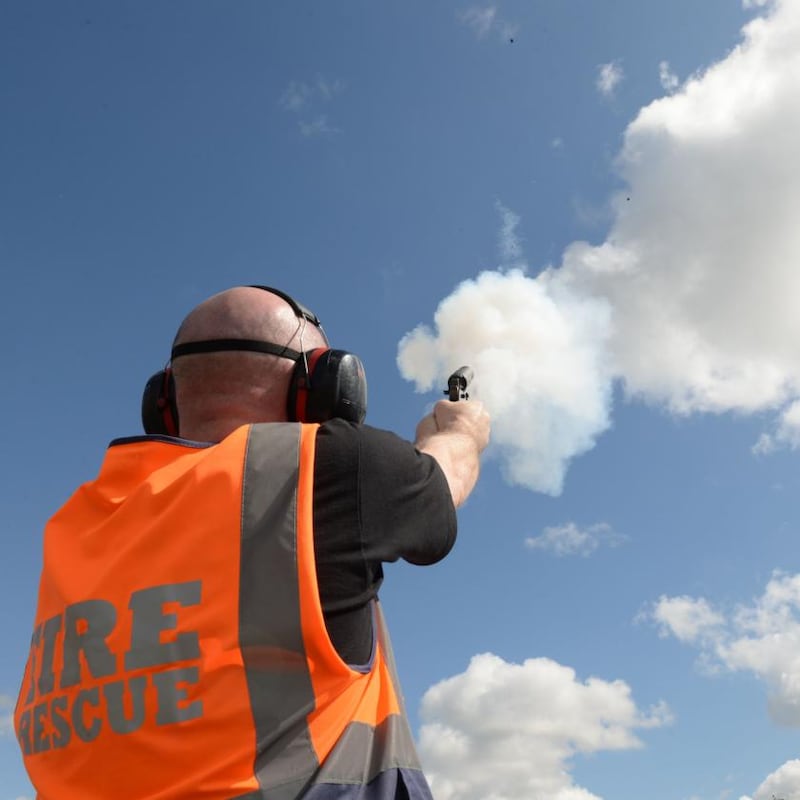
On average, there is one bird strike a day at Dublin Airport. That’s about what you’d expect for an airport of this size, says Keogh. “The international average for aircraft bird strikes is around 2.4 or 2.5 per 10,000 [plane] movements. We’re at 2.6 or 2.5. It wouldn’t be a bird going into an engine, but it could be a bird hitting a plane. We’re not going to eliminate bird strikes, but we have to try and reduce them to as minimal as possible.”
What they’re trying to avoid most of all is a multiple bird strike. “That’s as dangerous as you can get. That could actually bring down an aircraft.”
He shows me some photos of the damage to planes from bird strikes. “You can see each blade was damaged by the bird.” I count seven damaged blades. “Each one of those blades costs €90,000.”
The bird that forced an Aer Lingus plane to make an emergency landing suffering from engine failure in late July was, Keogh says, probably a stock dove. "We've sent the DNA off for testing. We'd be like CSI Miami here, swabbing stuff like that."
That strike proved so catastrophic because “it hit at the most dangerous time for an aircraft, which is when it’s taking off. Because it’s full of fuel, and it’s on the maximum engine revolutions to get off the ground. And literally that’s where the bird went into the engine.”
Keogh takes us to the animal morgue downstairs, a room with three freezer chests filled with bird and hare carcasses
One of the deterrents is the airport’s policy of keeping the grass around the runways long. “The reason why we have a long-grass policy is that these birds, when they’re in long grass, are afraid of predators. So it deters them for want of a better word.”
But the long grass policy creates its own problem. “The hares love long grass.”
It’s safe to say Keogh does not love the airport’s thriving population of hares, who are almost impossible to scare. “There was one of them out there a little while ago, just looking in at me,” he says darkly, pointing out his office window.
“We’ve tried loud noises, we’ve tried bangs, we’ve tried everything. And they just sit there and say, ‘How’re ye, lads?’ We had a pilot one day come on and say, there’s a mini kangaroo on the ramp outside the aircraft.”
Hares don’t damage aircraft – “They can’t fly, thank God. Yet” – but they frequently get hit by them, and hare carcasses attract birds. When a hare gets hit by a plane, Keogh’s team has to go straight out and scrape up the carcass, and hose down the runway.
He takes us to the animal morgue downstairs, a room with three freezer chests filled with bird and hare carcasses.
“What would you like to see? What have we got?” he says opening up the freezer and rooting inside. “Nice,” he says, pulling something out.
He hands over a large bag containing an almost fully intact gull and a frozen bread roll. “We keep everything because the ornithologist will analyse what’s in their tummies to see what’s attracted them to come to the airport. So, like, we would know with that seagull – it was a bread roll.
“There’s a pigeon now. He’s fully intact. No damage to him at all. He would have just hit a plane. Bang. And all his internal organs would be gone,” he says, passing over another one. I start to feel slightly nauseous.
You wouldn’t want to be squeamish in your line of work, I say, as he puts a hare back in the freezer.
“Yeah,” he chuckles. “The power went in here one weekend over the winter. It was like a crime scene in here.”
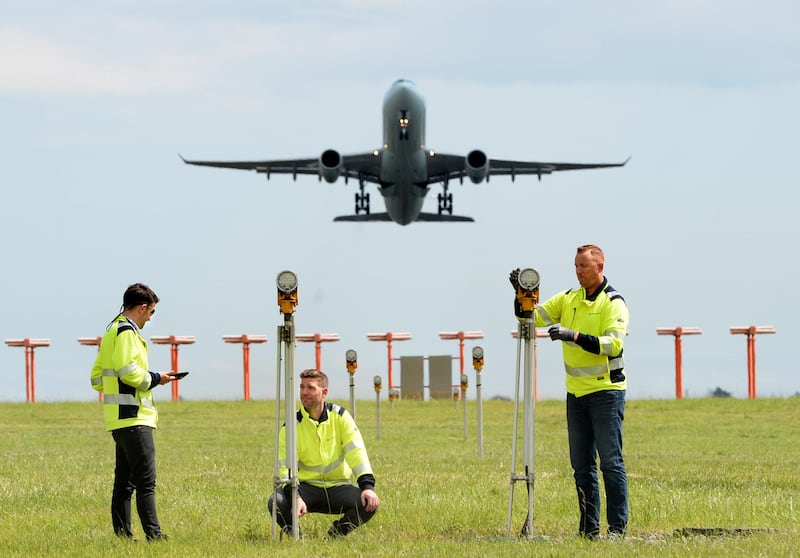
The next stop is at airfield maintenance, where a team of 49 engineers and 30 electricians manage the airfield, says Odhran McCann, airfield delivery manager.
His team’s remit includes overseeing the development of the new northern runway, maintaining the other runways – along with 2.4 million square metres of grass land, 1.6 million square metres of pavement, 15,000sq m of perimeter fencing and more than 5,000 light fittings. At all times, they have 450,000 litres of de-icing fluid ready to go should weather conditions demand it – which, during Storm Emma last year, they did.
The airfield maintenance team worked around the clock during the week of heavy snow, clearing 40,000 tonnes of snow off runways and taxiways using €10 million of equipment that had been invested in after the last major snowfall in 2010.
Between shifts, they would grab a few hours’ sleep in the airport hotels – some of them getting into beds that were still warm from the previous occupant. “There were so many of us here that week, we had to share rooms with the Terminal teams. I think the sheets were changed in between. I hope they were,” he says.
McCann’s team also maintains the airport’s 130 parking stands. But the task of deciding which aircraft parks in which spot falls to the 16-member stand allocation team, who operate out of a building known as the Pod.
Accessed up a narrow spiral staircase at the top of the terminal building, the Pod has the second best view in Dublin – after air-traffic control.
Today, Adrienne Peers, Claire Doyle, and Eoin Burke are on duty, sitting at a bank of computer screens showing maps of the parking stands, and spreadsheets allocating parking slots to individual aircraft.
Peers says they manage the movements of “up to 800 aircraft a day. That includes inbounds, outbounds, and we’ve a lot of towing aircraft as well. All the airlines have different preferences. They all want the best stands. We try and give them what they want.”
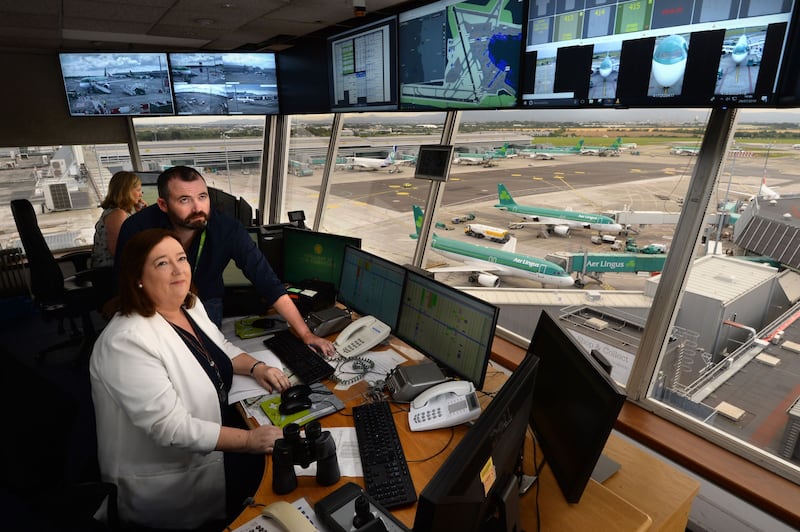
You have to have good spatial awareness to work here, says Burke. “And be good at multitasking. Which is why there are so many women here,” laughs Peers.
Problems happen when aircraft arrive early looking for a stand that’s not yet ready for them, leave late, or discover a mechanical problem, and find out they’re not going anywhere.
At the moment there’s an issue with an Evelop plane operated by Norwegian Air that’s parked up at one of the stands. “He came in this morning and he got towed away, and now he’s coming back to reload his passengers. But in the meantime he discovered a dent in his fuselage. So he’s going nowhere,” says Peers.
That will delay everything for the day, Doyle says.
The busiest part of the day is 5.45am-7.45am, when 14,000 passengers move through the airport. But the most stressful times, says Peers, are “when you’re holding people. You don’t want to keep passengers sitting on the plane for an hour, but there’s often absolutely nothing you can do about it.”
My final stop is behind the scenes at airport security, which is one of the busiest parts of the entire operation. Some 940 people work here; 120 staff are on duty at any one time. By the end of today, 34,000 people will have queued up to empty their bags of electricals, liquids, pastes and gels and pass through the scanner.
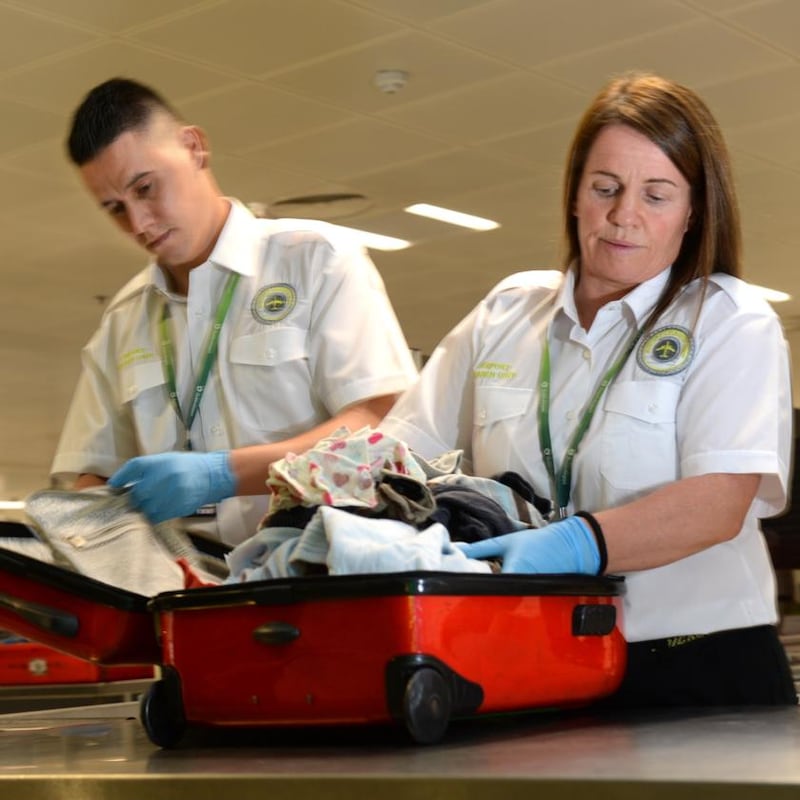
How do they decide who to do a full body search on? “It’s mostly random. You get people coming through and they say, ‘It’s always me, it’s always me,’ but it really is random,” says Ann Wright of the Airport Search Unit.
I tell her I suspect underwire bras set it off, and I’m secretly delighted when she confirms this. “A lot of underwire bras do set it off. Marks & Spencer’s are the worst.”
Supervisor Martin Flood says they have a target time of keeping all the queues under 30 minutes. An average of 450 people will come through each line every hour. I am dying to ask if they can settle an ongoing row in my house: do some lines move faster? (I say they all average out at about the same. My husband is always looking for the fastest-moving queue. Annoyingly, he’s right.)
“We have a saying in here: they’re like sheep,” says Flood. People drift in the same direction as the people in front of them. “So they’ll ignore two or three empty lanes.”
Geraldine O’Connor has brought in a selection of the “weird and wonderful” things confiscated from passengers.
“I mean this is lovely,” she says, holding up a what looks like a piece of modern art on a circular metal disc. “Except that’s a chainsaw blade. So that’s not going through.
“We’ve had swords, we’ve had machetes, we’ve had somebody bringing through a big piece of rock,” she says, fishing out of the box what is, indeed, a big piece of rock.
Why would somebody want to bring a rock on a plane? “It’s a bit of rock from the Cliffs of Moher,” she says, laughing. It’s more like the whole cliff.
Among the things most frequently confiscated are snow globes, says O’Donnell. “We’ve actually had to do a social media campaign telling people not to bring snow globes because of the liquid content.
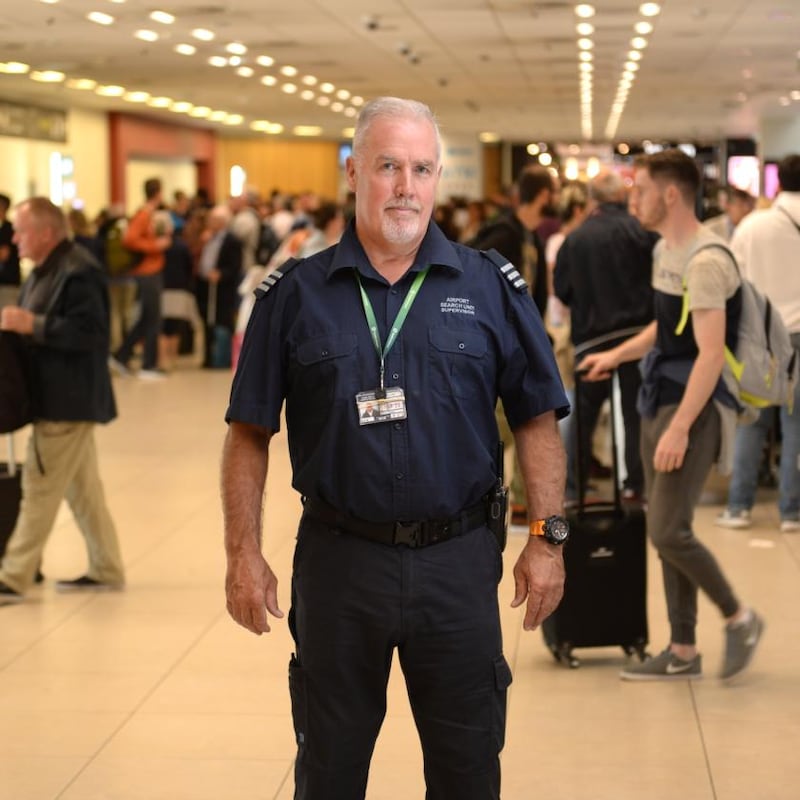
Toy Nerf guns are also problematic. Replica firearms are not allowed, and “if it can fire projectiles, it’s not going through”, says Flood.
The ones that are still brand new and boxed will go out to Temple Street or Crumlin children’s hospital or to the LauraLynn Foundation.
Contrary to popular suspicion, the large bottles of booze, perfume, cosmetics and Guinness sauce (Guinness sauce was very popular with passengers for a while, apparently) that get confiscated don’t go towards the DAA Christmas party – they also go towards making hampers for the charity-of-the-year programme.
“But do you know what the big thing is, and it’s a terrible thing to take off people?” says Wright. “Butter. They bring blocks of it. I’m not talking about Irish people going on holidays, I’m talking about Polish people, eastern Europeans. They love Irish butter.”
Someone tried to bring through a goldfish recently. “Like, the goldfish was okay, but he had to be kept in a bottle of water and that breaks the 100ml rule,” says O’Connor. “Somebody brought him back to their place in Malahide. I believe he’s still doing okay.”
Flood recently stopped a father and 10-year-old child. The child, apparently unbeknownst to the father, had a double-bladed Bowie knife in his carry-on luggage, given to him by a sibling.
“The father was as stunned as we were,” says Flood. All the same, airport police had to be called. “Our job is to stop it. Their job is to decide whether they use the section 50 or not and arrest them,” says Flood.
“We get all the excuses in the world. You empathise with people, but you need to be forthright when you have to be forthright. And the end of the day, we have to do our job.”
The most important skill for someone who wants to work in the Airport Search Unit is customer service, Wright says. She worked in the hotel industry for years before applying for a job here. She starts work at 3.20am every day. “I only live in Santry, so my alarm goes off at 2.30am.”
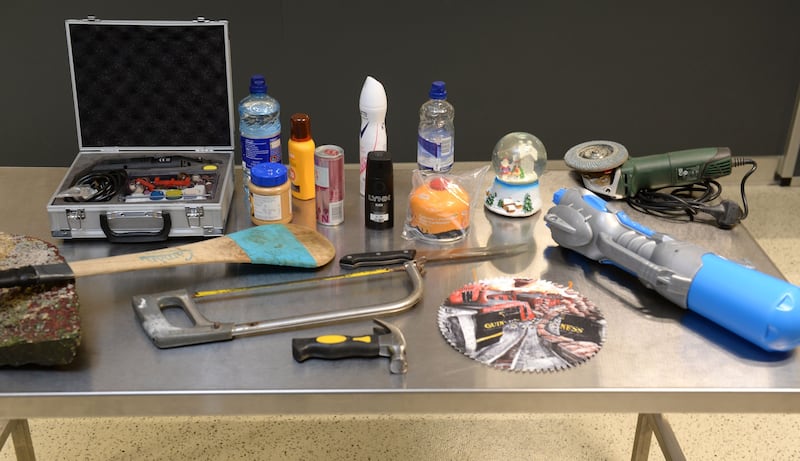
Each member of ASU sits at the screen for 20 minutes, before moving back on to the floor. “It generally takes an experienced person eight to 13 seconds to look at a bag,” says Flood.
“Any more than that, they’re looking at it because it’s what we call a ‘busy bag’, and it’s more than likely going to go for a bag search.” After 20 seconds, a timer goes, and the bag is sent down the rejection lane.
Wright says she can tell from looking at people in the queue who’s highly organised and going to get through quickly. After a while, you get to build a relationship with frequent flyers.
“I have a Monday man. I call him Mr Monday, and he comes through fast track on a Monday morning. I’ve another passenger on a Friday. He’s an Elvis impersonator.”
Most of the passengers are lovely, she says. And sometimes, when someone isn’t, there’s probably a good reason for it.
The thing you have to remember working here, says Flood, is “you never know what has happened to a person before they get to the airport, or where they’re going. They could be going on holidays, or they could be going to identify a family member’s body. You never know anybody’s reason for being here. So you have to treat everybody with respect.”
